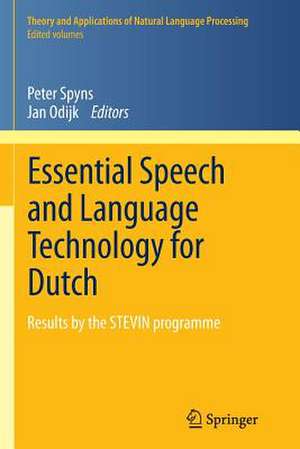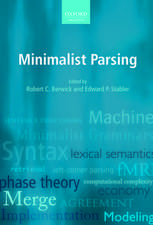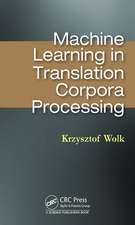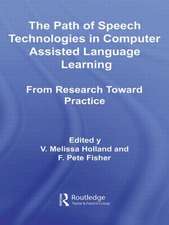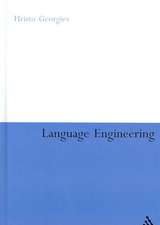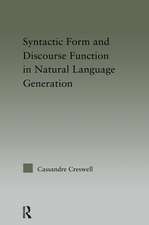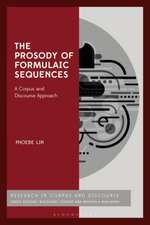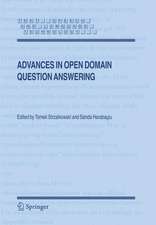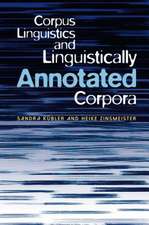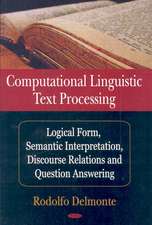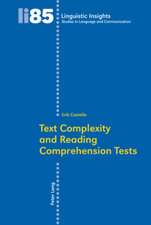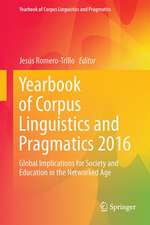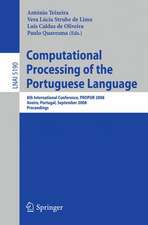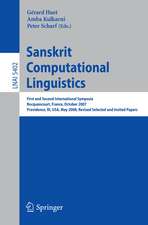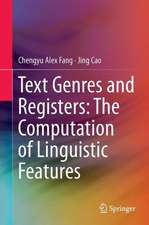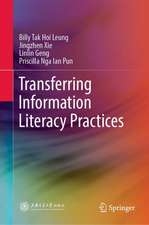Essential Speech and Language Technology for Dutch: Results by the STEVIN-programme: Theory and Applications of Natural Language Processing
Editat de Peter Spyns, Jan Odijk Cuvânt înainte de Linde van den Boschen Limba Engleză Paperback – 7 mar 2015
The contributions cover many areas of human language technology (for Dutch): corpus collection (including IPR issues) and building (in particular one corpus aiming at a collection of 500M word tokens), lexicology, anaphora resolution, a semantic network, parsing technology, speech recognition, machine translation, text (summaries) generation, web mining, information extraction, and text to speech to name the most important ones.
The book also shows how a medium-sized language community (spanning two territories) can create a digital language infrastructure (resources, tools, etc.) as a basis for subsequent R&D. At the same time, it bundles contributions of almost all the HLT research groups in Flanders and the Netherlands, hence offers a view of their recent research activities.
Targeted readers are mainly researchers in human language technology, in particular those focusing on Dutch. It concerns researchers active in larger networks such as the CLARIN, META-NET, FLaReNet and participating in conferences such as ACL, EACL, NAACL, COLING, RANLP, CICling, LREC, CLIN and DIR ( both in the Low Countries), InterSpeech, ASRU, ICASSP, ISCA, EUSIPCO, CLEF, TREC, etc. In addition, some chapters are interesting for human language technology policy makers and even for science policy makers in general.
| Toate formatele și edițiile | Preț | Express |
|---|---|---|
| Paperback (1) | 428.96 lei 6-8 săpt. | |
| Springer Berlin, Heidelberg – 7 mar 2015 | 428.96 lei 6-8 săpt. | |
| Hardback (1) | 436.57 lei 6-8 săpt. | |
| Springer Berlin, Heidelberg – 5 mar 2013 | 436.57 lei 6-8 săpt. |
Din seria Theory and Applications of Natural Language Processing
- 15%
 Preț: 651.19 lei
Preț: 651.19 lei - 20%
 Preț: 581.03 lei
Preț: 581.03 lei - 20%
 Preț: 637.23 lei
Preț: 637.23 lei - 20%
 Preț: 644.33 lei
Preț: 644.33 lei - 20%
 Preț: 641.87 lei
Preț: 641.87 lei - 20%
 Preț: 645.65 lei
Preț: 645.65 lei - 20%
 Preț: 643.97 lei
Preț: 643.97 lei - 20%
 Preț: 334.71 lei
Preț: 334.71 lei - 20%
 Preț: 334.38 lei
Preț: 334.38 lei - 20%
 Preț: 332.57 lei
Preț: 332.57 lei - 15%
 Preț: 645.60 lei
Preț: 645.60 lei - 20%
 Preț: 649.28 lei
Preț: 649.28 lei - 20%
 Preț: 716.23 lei
Preț: 716.23 lei - 20%
 Preț: 763.26 lei
Preț: 763.26 lei - 20%
 Preț: 818.54 lei
Preț: 818.54 lei - 20%
 Preț: 1004.48 lei
Preț: 1004.48 lei - 20%
 Preț: 938.18 lei
Preț: 938.18 lei
Preț: 428.96 lei
Nou
Puncte Express: 643
Preț estimativ în valută:
82.10€ • 85.39$ • 68.80£
82.10€ • 85.39$ • 68.80£
Carte tipărită la comandă
Livrare economică 13-27 martie
Preluare comenzi: 021 569.72.76
Specificații
ISBN-13: 9783642429927
ISBN-10: 3642429920
Pagini: 432
Ilustrații: XVII, 413 p. 79 illus., 29 illus. in color.
Dimensiuni: 155 x 235 x 22 mm
Greutate: 0.6 kg
Ediția:2013
Editura: Springer Berlin, Heidelberg
Colecția Springer
Seria Theory and Applications of Natural Language Processing
Locul publicării:Berlin, Heidelberg, Germany
ISBN-10: 3642429920
Pagini: 432
Ilustrații: XVII, 413 p. 79 illus., 29 illus. in color.
Dimensiuni: 155 x 235 x 22 mm
Greutate: 0.6 kg
Ediția:2013
Editura: Springer Berlin, Heidelberg
Colecția Springer
Seria Theory and Applications of Natural Language Processing
Locul publicării:Berlin, Heidelberg, Germany
Cuprins
Foreword. by Linde van den Bosch.- Introduction.- Peter Spyns.- Part I. How it started.- 2.The STEVIN Programme: Result of Five Years Cross-Border HLT for Dutch Policy Preparation. P.Spyns and E.D’Halleweyn.- Part II. HLT Resource-project Related Papers.- 3.The JASMIN Speech Corpus: Recordings of Children, Non-Natives and Elderly People. C. Cucchiarini and H. Van Hamme.- 4.Resources Developed in the Autonomata Projects. H.van den Heuvel, J-P.Martens, G.Bloothooft, M.Schraagen, N.Konings, K.D’hanens, and Q.Yang.- 5.STEVIN can Praat. D.Weenink.- 6.SPRAAK: Speech Processing, Recognition and Automatic Annotation Kit. P.Wambacq, K.Demuynck, and D.Van Compernolle.- 7.COREA: Coreference Resolution for Extracting Answers for Dutch. I.Hendrickx, G.Bouma, W.Daelemans and V.Hoste.- 8.Automatic Tree Matching for Analysing Semantic Similarity in Comparable Text. E.Marsi and E.Krahmer.- 9.Large Scale Syntactic Annotation of Written Dutch: Lassy. G.van Noord, G.Bouma, F.van Eynde, D.de Kok, J.van der Linde, I.Schuurman, E.Tjong Kim Sang, and V.Vandeghinste.- 10.Cornetto: a Combinatorial Lexical Semantic Database for Dutch. P.Vossen, I.Maks, R.Segers, H.van der Vliet, M-F.Moens, K.Hofmann, E.Tjong Kim Sang, and M.de Rijke.- 11.Dutch Parallel Corpus: a Balanced Parallel Corpus for Dutch-English and Dutch-French. H.Paulusen, L.Macken, W.Vandeweghe, and P.Desmet.- 12.Identification and Lexical Representation of Multiword Expressions. J.Odijk.- 13.The Construction of a 500-million-word Reference Corpus of Contemporary Written Dutch. N.Oostdijk, M.Reynaert, V.Hoste, and I.Schuurman.- Part III. HLT Technology Related Papers.- 14.Lexical Modeling for Proper Name Recognition in Autonomata Too.- B.Réveil, J-P.Martens, H.van den Heuvel, G.Bloothooft, and M.Schraagen.- 15.N-Best 2008: a Benchmark Evaluation for Large Vocabulary Speech Recognition in Dutch. D.A. van Leeuwen.- 16.Missing Data Solutions for Robust Speech Recognition. Y.Wang, J.F.Gemmeke, K.Demuynck, and H.Van Hamme.- 17.Parse and Corpus-based Machine Translation. V.Vandeghinste, S.Martens, G.Kotzé, J.Tiedemann, J.Van den Bogaert, K.De Smet, F.Van Eynde, and G.van Noord.- Part IV.HLT Application Related Papers.- 18.Development and Integration of Speech technology into COurseware for Language Learning: the DISCO Project. H. Strik, J. van Doremalen, J. Colpaert, and C. Cucchiarini.- 19.Question Answering of Informative Web Pages: How Summarisation Technology Helps. J.De Belder, D.de Kok, G.van Noord, F.Nauze, L.van der Beek, and M-F.Moens.- 20.Generating, Refining and Using Sentiment Lexicons. M.de Rijke, V.Jijkoun, F.Laan, W.Weerkamp, P.Ackermans, and G.Geleijnse.- Part V. And now.- 21.The Dutch-Flemish HLT Agency: Managing the Lifecycle of STEVIN’s Language Resources. R.van Veenendaal, L.van Eerten, C.Cucchiarini, andP.Spyns.- 22.Conclusions and Outlook to the Future. Jan Odijk.
Recenzii
From the book reviews:
“The book offers an impressive documentation of transnational joint research and development in language and speech technology from the past decade, that has been characterized by international reviewers as a front-running, exemplary effort. … it is a must-read for prospective BLARK developers, HLT resource centers, and language unions everywhere … .” (Antal van den Bosch, Machine Translation, Vol. 28, 2014)
“The book offers an impressive documentation of transnational joint research and development in language and speech technology from the past decade, that has been characterized by international reviewers as a front-running, exemplary effort. … it is a must-read for prospective BLARK developers, HLT resource centers, and language unions everywhere … .” (Antal van den Bosch, Machine Translation, Vol. 28, 2014)
Notă biografică
Dr. Peter Spyns works for the Flemish Department of Economy, Science and Innovation on innovation policy preparation, including human language technology and digital heritage. He is part-time seconded to the Dutch Language Union where he coordinated the STEVIN programme, supervises the HLT Agency, and participates in CLARIN-ERIC committees. Previously, he worked in academia and industry on medical language processing, ontology modelling and dialogue systems.
Prof. Dr. Jan Odijk is professor of Language and Speech Technology at Utrecht University. Previously, he worked more than 23 years in language and speech technology industry, both in the Netherlands and in Flanders. His current research focuses on infrastructures for humanities researchers that include language and speech technology services.
Prof. Dr. Jan Odijk is professor of Language and Speech Technology at Utrecht University. Previously, he worked more than 23 years in language and speech technology industry, both in the Netherlands and in Flanders. His current research focuses on infrastructures for humanities researchers that include language and speech technology services.
Textul de pe ultima copertă
The book provides an overview of more than a decade of joint R&D efforts in the Low Countries on HLT for Dutch. It not only presents the state of the art of HLT for Dutch in the areas covered, but, even more importantly, a description of the resources (data and tools) for Dutch that have been created are now available for both academia and industry worldwide.
The contributions cover many areas of human language technology (for Dutch): corpus collection (including IPR issues) and building (in particular one corpus aiming at a collection of 500M word tokens), lexicology, anaphora resolution, a semantic network, parsing technology, speech recognition, machine translation, text (summaries) generation, web mining, information extraction, and text to speech to name the most important ones.
The book also shows how a medium-sized language community (spanning two territories) can create a digital language infrastructure (resources, tools, etc.) as a basis for subsequent R&D. At the same time, it bundles contributions of almost all the HLT research groups in Flanders and the Netherlands, hence offers a view of their recent research activities.
Targeted readers are mainly researchers in human language technology, in particular those focusing on Dutch. It concerns researchers active in larger networks such as the CLARIN, META-NET, FLaReNet and participating in conferences such as ACL, EACL, NAACL, COLING, RANLP, CICling, LREC, CLIN and DIR ( both in the Low Countries), InterSpeech, ASRU, ICASSP, ISCA, EUSIPCO, CLEF, TREC, etc. In addition, some chapters are interesting for human language technology policy makers and even for science policy makers in general.
The contributions cover many areas of human language technology (for Dutch): corpus collection (including IPR issues) and building (in particular one corpus aiming at a collection of 500M word tokens), lexicology, anaphora resolution, a semantic network, parsing technology, speech recognition, machine translation, text (summaries) generation, web mining, information extraction, and text to speech to name the most important ones.
The book also shows how a medium-sized language community (spanning two territories) can create a digital language infrastructure (resources, tools, etc.) as a basis for subsequent R&D. At the same time, it bundles contributions of almost all the HLT research groups in Flanders and the Netherlands, hence offers a view of their recent research activities.
Targeted readers are mainly researchers in human language technology, in particular those focusing on Dutch. It concerns researchers active in larger networks such as the CLARIN, META-NET, FLaReNet and participating in conferences such as ACL, EACL, NAACL, COLING, RANLP, CICling, LREC, CLIN and DIR ( both in the Low Countries), InterSpeech, ASRU, ICASSP, ISCA, EUSIPCO, CLEF, TREC, etc. In addition, some chapters are interesting for human language technology policy makers and even for science policy makers in general.
Caracteristici
Bundles contributions of almost all the HLT research groups in Flanders and the Netherlands An overview of more than a decade of joint R&D effort in the Low Countries on HLT for Dutch An exemplary way of how to protect the interests of a medium (or smaller) sized language in the modern information and communication society? Includes supplementary material: sn.pub/extras
